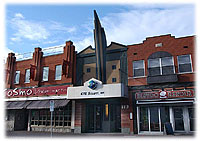The former Cartier Cinema
Promenade du Portage

In 1888, the land on which the future movie theatre would stand was sold to an Ottawa lawyer, Henry C. Monk, by the Trust and Loan Company of Canada, which had acquired it in 1877. On January 3, 1901, Monk sold the property to Caroline Dorion, wife of Napoléon Pagé, printer and newspaper publisher. She erected a three-storey wooden building with a brick facade, which housed offices. Ten years later, as Pagé was now a Crown Land agent in Nominingue, she sold the property to J.-Henri Bélanger, an insurance agent. At the height of the Depression, on April 10, 1933, Northern Life Assurance Company of Canada obtained the property at auction. They sold it to Interprovincial Theatres Limited of Toronto on June 25, 1936.
This company built a beautiful art deco cinema, designed by the renowned Emmanuel Biffa who had created several movie theatres in Montreal. The Cartier was inaugurated on March 25, 1937 with the screening of the film One in a Million, produced by Famous Players. The relatively narrow entrance of the building opened onto a marble staircase leading to a lobby with crystal chandeliers. The decor, the carpets and the walls were pure art deco. The walls of veined marble from Sainte-Geneviève were decorated with linear mouldings of painted plaster and semicircular mirrors giving the impression of a larger space. The ceiling was painted gold and silver. The atmosphere was enhanced by subtle neon lights. The auditorium, the largest theatre in the region, was a curved room with mirrors, thick carpeting, and 720 sofas and seats made expressly for the cinema. It was decorated with bas-reliefs of the Amerindians meeting Jacques Cartier. The wall lamps were half-globes painted blue and green to symbolize the sea and the continents. The projection equipment and the acoustics employed the latest technology, and the theatre was air-conditioned.
To attract a French-speaking clientele, the company named the cinema after the first French explorer to sail up the Saint Lawrence, Jacques Cartier, whose portrait graces the entrance to the building. The French name, however, was not indicative of the programming, as the majority of the films were in English, except on Thursday nights. Robert-Émond Maynard was the first manager of the cinema. On August 18, 1937, Famous Players Canadian Corporation Limited bought the property.
When the Cartier opened, it was the first time that the newspaper Le Droit, property of the Oblates of Mary Immaculate, covered the opening of a cinema. Before that, the religious community had been categorically opposed to this type of entertainment, considered a threat to the values of children and workers. There may also have been concerns other than morality. In 1927, several children had died in a fire at a Montreal movie house. After that, the government of Quebec denied children access to cinemas, which was not the case in Ontario. Probably the fact that Ontario cinemas were closed on Sunday, while those in Quebec remained open, was a factor in the position taken by the religious community. Famous Players took advantage of Hull's border location to show special Sunday screenings, aimed at Ontarians, and made sure to announce them in its Ottawa theatres during the week. But the films were almost exclusively in English, and the clergy saw this as a threat to the French language, deemed the guardian of the faith.
Paul-Hector Lafontaine, an employee and ultimately a friend of Donat Paquin, a founder of the cinemas in Hull, bought the Cartier in 1963, the same year that the Laurier Cinema, where he had been working as manager, was demolished. Born in Hull on February 28, 1910, Lafontaine started working part-time for Paquin at the age of 14. Lafontaine later became the manager of the Donat Paquin Ltée companies as well as the Laurier Cinema and the Electra Cinema in Montreal. He was a member of the Canadian Picture Pioneers and the Quebec Allied Theatre Industry. In 1968, Lafontaine sold the Cartier. Eventually, it began screening films of dubious quality and, finally, pornographic movies.
During a wave of restoration on the Promenade du Portage, the City of Hull closed the cinema and bought the building on November 1, 1991, without its furnishings or equipment. Sadly, the furnishings, seats and projectors will never enter our museum collections. On March 12, 1998, after several years of disuse, the building was purchased by the contractors Jacques Parent and Raymond Chauvet who transformed the former cinema into a high-tech training school.
|